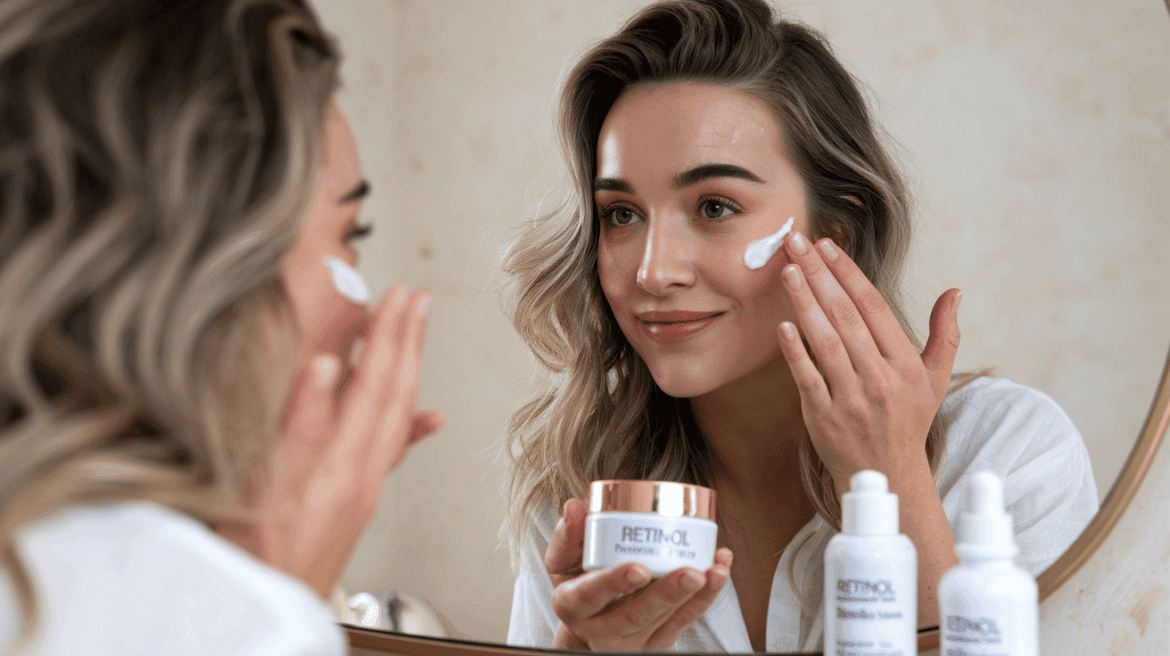If you use retinol topically in the right way, this miraculous skin ingredient can successfully tackle your acne, dark spots, fine lines, wrinkles, enlarged pores, excessive oiliness, and uneven texture.
The dermatologists explain that the change may not be instant, but it is guaranteed.
Contents
What is retinol?
Retinol, a derivative of vitamin A, has been a staple in dermatology for decades, known for its powerful effects on the skin cell turnover and the collagen production. The application of retinol products can be somewhat daunting because it is a bit more challenging than the friendlier skincare ingredients like hyaluronic acid, for example.
Firstly, retinol makes the skin much more sensitive to sunlight, so it is not wise to apply it just before going outside. It is recommended to use it at night.
Secondly, it can irritate the skin before you get used to the ingredient.
When you first start using retinol, you may notice redness, dryness, and irritation, especially around your eyes and mouth. If you apply it gradually, every 2 – 3 nights, and follow with a moisturiser over the retinol, you can minimise these side effects. The dermatologists advise that the reactions will subside after 1 – 2 weeks of use. If you plan to spend more time indoors and do not need to go out for meetings, it is a great time to add retinol to your skincare routine at home.
The names can sometimes be confusing, but you should know that retinol comes in various formulations – retinoid (with a higher concentration), retinoic acid, and tretinoin, all of which are variations of the same compound and work in the same way.
Retinoids are the broader class of compounds, including the over-the-counter options like retinol and the prescription-strength formulations such as tretinoin.
Retinoic acid is the active form that directly affects the skin cells, but retinol must first be converted into retinoic acid within the skin.
How Retinol Works
Retinol works by increasing the cell turnover, meaning it helps the skin shed its old, dead cells and produce new ones more rapidly. This process helps to unclog the pores, reduce the acne outbreaks, and improve the skin texture. Additionally, the retinol stimulates the production of new blood vessels in the skin, which improves the skin color. It also helps to fade the age spots and soften the rough patches of skin.
How to Apply Retinol

Retinol should be applied at night to clean and dry skin before a moisturising product. In the morning, you need to cleanse your skin and hydrate it again with a product that must contain a sun protection factor (SPF). And if you want the retinol to really work to your advantage, you need to commit to it indefinitely. It takes a minimum of 90 days to start witnessing the results. Your skin will look younger, firmer, and clearer. But you need to continue using the retinol for at least a year longer to maintain the effects.
The dermatologists recommend you to reduce your use of exfoliating products and acids when applying retinol, since retinol itself acts as a gentle exfoliant. It is also good to use alpha or beta hydroxy acids for topical application. However, it is crucial to balance these to avoid over-exfoliation, which can lead to irritation and sensitivity.
Building a Skincare Routine with Retinol
Building a skincare routine with retinol involves a few essential steps:
Start slow
Begin with a lower concentration of retinol (0.25% or 0.3%) and apply it every 2 – 3 nights. As your skin builds tolerance, you can increase the frequency to nightly use.
Hydrate and protect
Always follow your retinol application with a good moisturiser to keep your skin hydrated and to mitigate the potential dryness. In the morning, never skip your sunscreen, as retinol increases the skin’s photosensitivity.
Avoid mixing with certain products
Retinol can be potent, so avoid using it in combination with other strong actives like benzoyl peroxide or vitamin C in the same routine to prevent irritation.
Be patient
Understand that retinol takes time to demonstrate its visible results. Its consistent use over the course of a few months is key to the achievement of a smoother, clearer, and more youthful-looking skin.
Long-Term Benefits of Retinol

Reduction of fine lines and wrinkles
By stimulating the collagen synthesis, retinol helps to diminish the appearance of fine lines and wrinkles. This leads to a smoother and firmer skin over time.
Improvement of skin texture and tone
The regular use of retinol can even out the skin tone, reducing the hyperpigmentation and dark spots. It also refines the skin texture, making it appear more radiant and youthful.
Acne management
Retinol’s ability to increase the cell turnover aids the prevention of the acne formation by keeping the pores clear. It can also reduce the appearance of the post-inflammatory hyperpigmentation that results from acne scars.
Pore minimisation
Over time, retinol can help reduce the size of the pores by keeping them clear and promoting a more even skin texture.
Enhanced absorption of the other skincare products
As retinol helps to clear away the dead skin cells, it allows for a better absorption of the other skincare products, boosting their effectiveness.
The incorporation of retinol into your skincare routine can yield significant long-term benefits, transforming your skin’s texture, tone, and overall appearance. While it requires a period of adjustment and consistent use, the results are well worth the effort. By understanding how to use retinol correctly and integrating it in a supportive skincare routine, you can enjoy a more youthful, radiant complexion for years to come. Always consult with a dermatologist to tailor the use of retinol to your specific skin needs and to navigate any potential side effects effectively. With patience and dedication, retinol can be a powerful ally in your journey towards your healthier and more vibrant skin.


